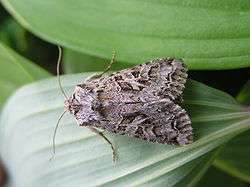Hada plebeja
Hada plebeja, the shears, is a moth of the family Noctuidae. It is found in Europe and across the Palearctic to Asia Minor, Armenia, Turkestan, Central Asia, Mongolia, Siberia. Also Kashmir.[1][2]
| Shears | |
|---|---|
 | |
| Scientific classification | |
| Kingdom: | |
| Phylum: | |
| Class: | |
| Order: | |
| Family: | |
| Genus: | |
| Species: | H. plebeja |
| Binomial name | |
| Hada plebeja (Linnaeus, 1761) | |
| Synonyms | |
| |
Technical description and variation
The wingspan is 30–35 mm. The length of the forewings is 14–17 mm. Forewing lilac-grey, suffused with olive fuscous, deepest in median area; claviform stigma small, black-edged, followed by a broad bidentate pale patch at base of vein 2; orbicular and reniform pale grey with white edges; marginal area dark; submarginal line preceded by black dentate markings: veins more or less grey-scaled; hindwing fuscous, paler basewards; the fringe pale; - leucostigma Haw. has the ground colour whiter; hilaris Zett. is a form of this in which the whitish orbicular and the pale blotch on vein 2 are confluent and form one long streak; ochrea Tutt is a form, common in Britain, in which the forewing is varied with yellow scales: - latenai Pierr. is a melanic mountain form from Switzerlandand the Hebrides.[3]
Biology
The moth flies from early June to early July.[4] Larva dark brown; dorsal and lateral lines pale; subdorsal lines formed of dark lunular blotches: spiracles black; head glossy black. The larvae feed on smooth hawksbeard, Hieracium pilosella, Taraxacum and alfalfa.[5] preferring the roots.
References
- Colour Atlas of Siberian Lepidoptera
- Lepidoptera and their ecology
- Seitz, A. Ed., 1914 Die Großschmetterlinge der Erde, Verlag Alfred Kernen, Stuttgart Band 3: Abt. 1, Die Großschmetterlinge des palaearktischen Faunengebietes, Die palaearktischen eulenartigen Nachtfalter, 1914.
- Hada plebeja Funet.fi - Finland Centre for Science, retrieved on 11 October 2009
- "Robinson, G. S., P. R. Ackery, I. J. Kitching, G. W. Beccaloni & L. M. Hernández, 2010. HOSTS - A Database of the World's Lepidopteran Hostplants. Natural History Museum, London".